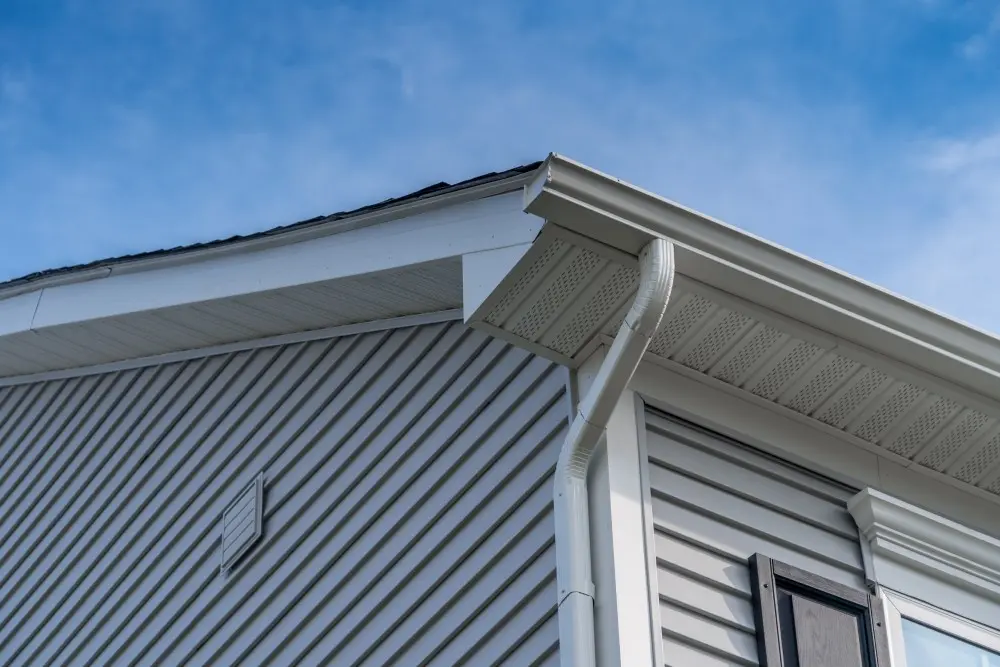How Much Does Siding Cost in the Chicago Area?
- 25min
- Updated:9/29/2025
- ByShaunak Ahuja
Your home is an investment, and if you need new siding, you might not know what to expect in terms of cost. Transparency is important to us at HX Home Solutions, so we’ve put together an interactive siding calculator. This tool helps homeowners estimate project costs based on current Chicago area pricing for materials and installation.
This calculator helps you:
- Compare material options: See cost differences between fiber cement, vinyl, engineered wood, and stone veneer.
- Visualize budget requirements: Get a breakdown of material, labor, and additional costs.
- Plan your investment: Understand how different options impact your total project cost.
Siding Materials We Offer
We partner with industry-leading manufacturers to provide the highest quality siding materials for Chicagoland homes.
James Hardie Fiber Cement
James Hardie fiber cement is America's number one siding choice, installed on over 8 million homes nationwide. Engineered specifically for the Midwest's climate extremes, Hardie siding withstands freezing temperatures, high humidity, and intense UV exposure without deterioration.
Mastic Vinyl Siding
Mastic vinyl siding is exceptionally durable and has a more accessible price point. It’s available in over 40 colors and numerous profiles, including lap, vertical, and shake styles, Mastic siding resists fading with SolarDefense UV protection technology.
Metal Siding
Metal siding delivers unmatched durability with a lifespan exceeding 50 years and resistance to fire, insects, and extreme weather conditions. Modern metal siding systems incorporate energy-efficient insulation backing and can even reduce heating and cooling costs by 5-15 percent.
LP SmartSide Engineered Wood Siding
LP SmartSide combines natural wood appearance with enhanced durability through its proprietary SmartGuard manufacturing process. This engineered wood product resists impact damage up to 200 percent better than fiber cement, while being 39 percent lighter for easier installation.
NorthStar Stone Veneer
Manufactured at our own Indiana facility, North Star Stone veneer adds distinctive character with 27 textures and color options. Our stone veneer is significantly lighter than natural stone (approximately 8-12 lbs per square foot vs. 35-45 lbs), eliminating the need for additional structural support.
How to Calculate Your Siding Cost
The HX Home Solutions calculator provides a general cost estimate based on your home's dimensions and material selections. While professional siding installation involves detailed measurements and assessments of architectural features, this tool is a helpful starting point for budget planning.
We know that sometimes, a general estimate might not suffice. For an exact quote, we provide free on-site measurements that account for all project-specific variables.
Here’s how to use our calculator.
Step 1: Enter House Dimensions
Enter your home's length, width, height, and number of stories. Our calculator uses a simplified formula that accounts for typical window and door openings:
Formula:
Perimeter = 2 × (Length + Width)
Wall Area = Perimeter × Wall Height × Number of Stories
Net Siding Area = Wall Area × 0.8 (standard 20 percent reduction for windows/doors)
Pro Tip: For a more precise measurement, walk around your home and measure each wall section individually, subtracting large openings like picture windows and garage doors.
Step 2: Specify Gable Details
Indicate whether your home has gable ends and enter their dimensions if applicable. Here’s how to calculate the gable area:
Formula:
Gable Area = 0.5 × Gable Width × Gable Height × Number of Gable Ends
Total Area = Wall Area + Gable Area
Pro Tip: Most two-story homes have 2 gable ends, while more complex roof designs may have 4 or more. Gables can account for 10-15 percent of your total siding area.
Step 3: Select Your Siding Materials
Choose your preferred siding material and style. Each material has different base costs, and style variations affect material and labor expenses.
Note: While fiber cement siding like James Hardie products has a higher upfront cost, it consistently ranks as the highest return on investment for exterior remodeling projects. According to the latest Cost vs. Value Report, fiber cement siding replacement projects recover up to 86 percent of their cost at resale, so it’s an excellent long-term investment for your home.
Step 4: Choose Additional Components
Select additional project components like old siding removal, house wrap, insulation, and trim packages.
Pro Tip: While adding insulation increases your upfront cost by $2-3 per square foot, it can reduce energy costs by 5-15 percent annually, typically recouping the investment within 5-7 years.
Step 5: Review Your Estimate
The calculator provides a detailed breakdown of:
- Total siding area
- Material costs
- Labor costs
- Additional component costs
- 10 percent contingency amount
- Estimated total project cost
Pro Tip: For more complex homes with multiple levels, dormers, or architectural details, add 15-20 percent to the calculated estimate, accounting for additional material and labor requirements.
Calculation Example: 2,000 Square Foot Home
For a typical 2,000 square foot two-story home (approximately 30'×40' with 9' ceilings), here's a basic vinyl siding project estimate:
Perimeter: 2 × (30' + 40') = 140 linear feet
Wall Area: 140' × 9' × 2 stories = 2,520 sq ft
Standard Window/Door Reduction: 2,520 × 0.8 = 2,016 sq ft of siding needed
With basic vinyl siding ($5.50/sq ft installed), house wrap, and standard trim:
Materials and Labor: 2,016 sq ft × $5.50 = $11,088
House Wrap: 2,016 sq ft × $0.50 = $1,008
Basic Trim Package: 2,016 sq ft × $0.75 = $1,512
Old Siding Removal: 2,016 sq ft × $1.50 = $3,024
Permit and Miscellaneous: $500
Subtotal: $17,132
Contingency (10 Percent): $1,713
Total Project Estimate: $18,845
Why Include a Contingency in Your Estimate?
A 10 percent contingency allowance protects against unexpected costs that commonly arise during siding projects. You never know what could come up during a project, so it’s better to be prepared. This buffer helps ensure your project stays on budget despite unforeseen circumstances.
Factors that may affect your contingency needs:
- Hidden damage: Rotted or damaged sheathing and framing become visible only after removing existing siding.
- Additional repairs: Flashing replacement, trim repairs, or minor carpentry work are often needed around windows and doors.
- Material fluctuations: Price changes between the estimate and the actual purchase date, especially for specialized colors or styles.
- Weather delays: Extended project timelines due to unsuitable installation conditions.
- Code compliance updates: Additional requirements from local building departments during permitting or inspection.
Key Factors That Impact Your Siding Project Cost

Material Selection
The siding material you choose typically represents 40-60 percent of your total project cost. This decision also has the greatest impact on long-term performance, maintenance requirements, and home value.
Material choice typically accounts for 40-60 percent of your total project cost:
- Vinyl siding: Most affordable at $5-7 per square foot installed.
- Engineered wood: Mid-range option at $7-9 per square foot installed.
- Fiber cement: Premium choice at $11-13 per square foot installed.
- Metal siding: Specialized option at $8-12 per square foot installed.
- Stone veneer: Luxury accent material at $30-50 per square foot installed.
Home Configuration and Size
Your home's characteristics significantly impact total project cost:
- Square footage: Larger homes require more materials and labor.
- Stories: Multi-story homes increase installation complexity and safety requirements.
- Architectural complexity: Dormers, bump-outs, and complex rooflines add 15-30% to labor costs.
- Existing conditions: Homes with accessibility challenges, like steep slopes or limited access points, increase labor time.

Installation Components
Critical components beyond the siding itself affect both performance and cost:
- House wrap: Weather-resistant barrier costs $0.40-0.60 per square foot installed. This critical moisture control layer prevents water infiltration and allows vapor to escape, protecting your home's structure from rot and mold. Modern house wraps also provide air infiltration resistance, improving energy efficiency.
- Insulation: Rigid foam insulation adds $2-3 per square foot but improves energy efficiency. Insulated siding systems can increase your home's R-value by R-2 to R-5, potentially reducing heating and cooling costs by 5-15 percent annually in Chicago's climate zones.
- Trim packages: Range from $0.75 to $3.00 per square foot, depending on complexity. Beyond aesthetics, properly installed trim creates water-tight transitions between siding panels and around openings. Premium trim packages enhance curb appeal while providing superior weather protection at vulnerable points.
- Flashing and accessories: Critical water management components add $1-2 per square foot. Properly installed flashing around windows, doors, and other penetrations prevents 80-90 percent of potential water intrusion issues, which can extend your siding's lifespan significantly.
Professional Installation Process
Our installation process follows industry best practices to ensure lasting performance:
- Site preparation: Protecting landscaping, windows, and adjacent surfaces.
- Existing siding removal: Complete removal and proper disposal of old materials.
- Substrate inspection: Identifying and repairing any damaged sheathing or framing.
- Weather barrier installation: House wrap and flashing for moisture protection.
- Insulation application: Adding insulation when specified.
- Starter strips and trim: Installing foundation components for proper water management.
- Siding installation: Applying materials according to the manufacturer’s specifications.
- Detail work: Properly finishing around windows, doors, and other penetrations.
- Final inspection: Comprehensive quality check before project completion.

Can I Install Siding Myself?
We believe in transparency at HX Home Solutions. Siding installation is a project that skilled homeowners with construction experience can tackle themselves. You don't need to call a contractor immediately if you're comfortable with moderate to advanced home improvement projects and have the necessary tools and safety equipment.
However, before embarking on a DIY siding project, it's important to understand what you're committing to:
- Technical complexity: Each siding material requires specific installation techniques, tools, and fastening systems.
- Safety concerns: Working at heights requires proper equipment and safety protocols.
- Material waste: Inexperienced installers typically generate 15-25 percent more material waste.
- Weather barriers: Proper house wrap and flashing installation are critical for preventing moisture damage.
- Code compliance: Installation must meet local building codes and may require permits and inspections.
- Time investment: Professional crews complete in days what often takes DIYers weeks or months.
- Warranty considerations: Many manufacturer warranties need professional installation to remain valid.





